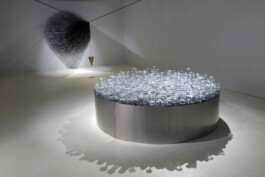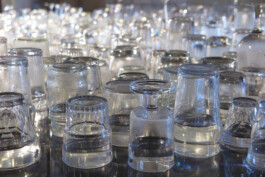RANDOM WALK | SOLO EXHIBITION
Artists Residence Herzliya, Israel | 2019
Curator: Ran Kasmy-Ilan
▷▷▷ NEWS: Random Walk was chosen for Japan Media Arts Festival 2020 Jury Selection!
Wrote about the exhibition:







“Random Walk” is a mathematical process describing random behaviors over time. This installation, taking up the entire gallery space at the Herzliya Artists’ Residence, comprises three parts: Cause, Effect, and Ripple. At the center of the exhibition stands the Cause - a coin-tossing machine that makes randomness tangible with form.
The coin-toss results are analyzed, converted into digital values, and affect the second component - the Effect. A large cone built from 1,165 narrow black elastic bands, burst out of the gallery wall. An engine pulls the conic structure in varying directions, set by the coin-tosses outcomes.
A camera records the cone’s movements, which then activate Ripple, the third element. A circular metal dais holding hundreds of upside-down glasses, each half-full of water. A magnetic mechanism responds to motion in the space, agitating the water and reflecting the ongoing changes around it.
Random Walk explores our illusion of control and free will in the face of randomness and powerful forces that shape our lives. This theme of randomness recurs throughout Liat Segal’s work and continues in pieces such as Random Walk 2.0, Stone Sorting Machine, Plate Recorder, and others.

Curator's Text | Ran Kasmi Ilan
This is a time of absolute truths: black or white, good or bad, profit or loss, one or zero. No third possibility exists. We have internalized the language of code and are now trying to apply it to every decision, every perception, every choice. We wish to present everything on a uniform scale, as if every ethical dilemma, financial plan, and culinary selection can be broken down into a single currency, an established exchange. As if we can apply the same principles to choosing a washing machine, our lifelong profession, or the values we instill in our children.
This concept of a standard measurement is, of course, an illusion. And yet, it is an important illusion. In a world so overwhelmingly complex, this concept enables us to imagine our lives as a series of logical steps and choices – lives that can be foreseen with sufficient data and processing power. As if the world was comprised of a clear set of causes and effects, and not a chaotic array starring a revolving sword of arbitrary randomness looming over our heads.
The fundamental language of binary code reigns over all. Incapable of encapsulating the human experience with all its intricacies and subtleties. However, it is its tyrannical and rigid nature that draws us to try and grasp it with both hands as our salvation. The very idea that there are no absolutely right or absolutely wrong choices, and that even if they did exist, we would be unable to make them, is too difficult to tolerate.
“Random Walk” is a mathematical process that describes random motion over time. In the very center of her new solo exhibition, artist Liat Segal has positioned a machine that makes this chaotic movement tangible with form. This installation, taking up the entire gallery space of the Herzliya Artists’ Residence, is comprised of three parts: cause, effect, and ripple.
Cause: The cause is a large metal cylinder, a raised platform positioned as an altar, at its head a stretched piece of black latex. A coin rests on the latex. An internal mechanism sucks in and then releases the latex every few seconds, allowing the coin to bounce up continuously, an eternal round of heads or tails, ad infinitum. This is a flipistical machine. It holds only two possible outcomes. Both are absolute. Neither it no you have the power to influence which outcome is presented. The tally is inevitable, involuntary, and uncontrollable. Distribution is uniform and discrete, random and repetitive. Fate tosses a coin and it spins and falls, a finality. That is the very nature of coin tossing – it eases those difficult moments when we have to decide between different possibilities and have no crucial data to rely on, or when the options have no common moral ground to compare and evaluate.
The result of each toss is recorded by the camera positioned above the cylinder. It is presented in binary values on an electronic screen, updated every few seconds. The flashing numbers provide empirical readings of the coin toss. Can this screen be trusted? That remains unclear. The screen points ahead to the other two elements of the machine.
The tossed coin is a single dollar from a series coined in 1979-1981 with the image of Susan B. Anthony, one of pioneers of the women’s rights movement. It was the first American coin to depict a woman. Never popular, its production was stopped quickly. Alongside Anthony’s profile is the famous inscription “In God We Trust”, the official American motto from 1956 onwards. On the other side, over the head of a bald eagle bearing an olive branch, is a Latin inscription: E PLURIBUS UNUM (“Out of many, one”), throughout 1872-1956 another US motto. Thus, one side of the coin tends to determinism, while the other espouses the unity formed from melding many individual identities often in contention and without the ability to tip the scales either way. Alternatively, it may be that the symbolic significance of the coin is nothing but the undersigned attempt to find a pattern, to connect the dots in the search for comprehensible meaning.
Indeed, we spend our lives endlessly seeking out patterns and adhering to rules. If some rules are still lacking, we’ll invent them. We are aware that sequences of events may transpire at random but prefer to believe in causality. Pitching our expectations into the universe in the hopes it adjusts accordingly.
Effect: The coin’s guidance activates the second component of this machine by Segal. Here, the circle at the base of the cylinder from the first element – the cause – reappears on a larger scale, now on the opposite gallery wall. Here also the circle provides a base, but now bears the weight of a cone comprised of 1,165 narrow black polyurethane bands that bursts out of it, extended tautly towards a point in the center of the space. A shining metal ring holds them, a shackle floating mid-space, an inverted vanishing point that sketches a delicate and precise three-dimensional image.
The black mass narrows down to a pinprick. The bands leave the perimeter on the wall to blend into a glowing dark form. Out of many, one. This wonder, hovering between heaven and earth, is possible thanks to constricting forces powered by two mechanical belts that pull the cone up and sideways, along with the brass weight pulling it down.
The coin tossing outcomes are translated into values, these are fed into the engine as it pulls the belts in different directions. The shackle shifts imperceivably as the belts and weights move. The cone sways slowly from side to side, its bands bunching and relaxing, reflecting the light, a vibrating shadow of thousands of diagonal lines on the wall and floor. Like a huge animal snout, its movements measured and clumsy, each made up of countless details and fragments of force. The coin toss awakens the ghost within the machine, undermining the perception that the cone is merely an inanimate object.
We attribute life to the cone because of its motion, but also thanks to the aesthetic choices made by Segal: the circular manacle, the bands so reminiscent of reins, the ropes. We associate the powers at play with some social, or interpersonal meaning. If the means to bind something are here, there must be something meant to be bound, something to discipline. Control indicates someone has surrendered.
We cannot be indifferent to what we identify as an object when it begins to move in a way that gives it the impression of life. We naturally tend to project our humanity beyond the bounds of where humanity ends. We attribute a will to lifeless objects and experience intense emotional reactions when faced with machines. This familiarity with machines works in two directions; we have been accustomed to thinking of ourselves as intelligent machines. Thinking machines. Survival machines. among the myriad metaphors of the digital age, we see our cognizance as a data processing mechanism.
Ripple: The cones motion in the space is recorded by another camera, and the shackle’s placement activates a third movement.
The circle appears again in the machine’s third component. At first, the coin and platform were raised; a small circle inside a larger one. Then the circle appeared on the wall, where it served as the base of the black-banded cone. Its diameter has expanded. Now, in the third movement, it grows yet again.
Circles are perfect, continuous. No beginning or end, no corners or angles. Every point on the circumference is equally distant from the center. The constant ratio between diameter and circumference always remaining the same (irrational). The circle’s shape is an abiding image, with examples too many to number, from tribal gathering circles, Dante’s nine circles of hell, Christian saintly halos. Circles are timeless. Divine, as befitting a symmetrical shape so flawlessly balanced. The circular space provided by Segal also carries its own ritualism. It pulls at the senses, as we prefer the ceremony over bare reality. It simplifies matters. It offers security. A promise of salvation, or at the very least – control.
The ripple, the third element, is a round metal dais. Its surface is black and glossy. Hundreds of clear cups of water, of varying sizes and shapes, are stationed atop it. They are upside down, their rims resting on the dais, each half-filled with water. Each also contains several tiny magnets. Hundreds of transparent incubators, miniscule nests with a tiny magnet nestling.
The cone’s motion causes ripples within the upside-down cups, and triggers the motion of additional, invisible magnets placed under the dais. In turn, this movement stirs the minute magnets in the cups. Called to action, they respond instantly, jumping in all directions, bouncing within the clear walls of the cup encapsulating their private universes, agitating the water and then dropping still. Awaiting the next call. A community of single units, each trapped in their individual bubbles, rattling along together, knocking against translucent, perfectly round cages. Their movements are similar, but separate. They constitute a complex system, they are a mass.
In its automatic-arbitrary autonomy, Segal’s machine has no regard for the significance of its motion, motion neither positive nor negative. Statistically speaking, the longer the coin gets tossed and the various forces remain at play, the action averages out but the variance increases: in most cases, it stays close to the average, but over time the probability of reaching the extremes rises.
Segal, an artist that began a career path in the fields of computer science and biology, translates information and complex systems into physical spaces. She deals in the questions of existence in the age of Big Data by materializing them. And when data is tangible, when we can stand beside it, study it with our own eyes, we may learn something about ourselves, about free will and the choice of this time – right now.
In her work, Segal attempts to control the uncontrollable, to regulate the arbitrary, to contain excess complexity. She is well aware how impossible this is, but nevertheless continues. And why not? Knowing something is impossible has never stopped us from wanting it. This desire is a raw substance, a catastrophe, and also life. What has been shall remain, and what was done will continue to be done. Unless we choose otherwise.